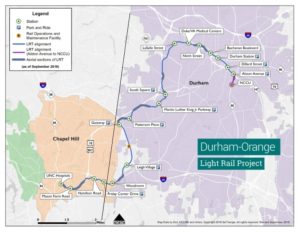 On October 4th, Go Triangle and Chapel Hill Planning Director Ben Hitchings made a presentation to the Town Council and the Orange County Commissioners on the Gateway Station area in northern Chapel Hill. The presentation relied on a study conducted by Gotriangle.
On October 4th, Go Triangle and Chapel Hill Planning Director Ben Hitchings made a presentation to the Town Council and the Orange County Commissioners on the Gateway Station area in northern Chapel Hill. The presentation relied on a study conducted by Gotriangle.
Included in the presentation were economic projections for the Gateway Station which, represents the town and County’s most significant opportunity for economic development along the line.
The projections, based on a high density scenario, would result in accumulated property tax revenues for the station area through 2057 of $70 million for Durham County, Orange County and Chapel Hill combined.
Reacting to this new information, Commissioners Jacobs and McKee expressed surprise, stating that the new numbers are far lower than GoTriangle previously projected.
Others at the dais, including Mayor Hemminger and Council Members Gu and Anderson questioned GoTriangle about the projections and associated costs but were told that the data isn’t available yet.
Concerns were also raised about full tax projections for UNC Health’s 48 acre property.
Missing from the GoTriangle and Chapel Hill Planning presentation were the following points:
- Assumptions about density, worker access to jobs and other numbers being shown.
- Estimates of tax revenues broken out by county for the Gateway station area which spans the Durham-Orange county line.
- Information about the impact of rising rail costs on future funding fir Chapel Hill transit and Orange Public Transit to meet the needs of our broader community and not just serve the rail line in the future.
- Stormwater data that will delineate the most buildable areas, thus avoiding putting buildings in places likely to flood and to identify the necessary stormwater infrastructure investments needed to prevent flooding downstream.
Subsequent to Wednesday’s meeting, the Herald Sun reported that debt for the light rail has increased to $850-$900 million – bringing the project to nearly $3.4 billion. CHALT remains deeply concerned about the $3.4 billion cost of the Durham Orange Light Rail Transit (DOLRT) because:
(1) the project route does not connect to downtown Chapel Hill or to other economic development centers in town;
(2) it does not provide access to transit for low-income workers and for those individuals who are unaffiliated with UNC who need transit;
(3) the financial structure ties Orange County to long term debt until 2064;, and
(4) that our transit money will not be available for near-term projects such as more frequent bus service and Bus Rapid Transit. Don’t know much about BRT? Check it out here.
